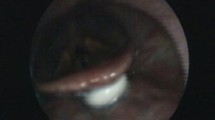Summary
Water-soluble contrast media, which have been employed in the examination of the lumbar spinal canal for 30 years, can sometimes result in severe complications, such as arachnoiditis, epileptic seizures, and myoclonic spasm. These complications have been seen less frequently since the advent of metrizamide, a new non-ionic water-soluble contrast medium. However, a further neurological complication has now arisen-mental disorder, varying in kind and degree; for example, organic psychosis and perceptual disturbance. Some characteristic cases are described. A series of 75 patients, all of whom received varying amounts of metrizamide for the purpose of cervical, thoracic and lumbar myelography, has been studied. Seven patients were found to have a pronounced organic psychosis and three patients had visual illusions or hallucinations. It is suggested that there is some degree of correlation between the total amount of iodine received and patient age. By careful enquiry and examination, similar disturbances were also found some 4–8 h after myelography with other water-soluble contrast media.
Similar content being viewed by others
References
Drayer, B. P., Rosenbaum, A. E.: Metrizamide brain penetrance. Acta Radiol. [Suppl.] (Stockh.) 355, 280–293 (1977)
Eldevik, O. P., Haughton, V. M.: Risk factors in complications of aqueous myelography. Radiology 128, 415–416 (1978)
Gonsette, R. E., Brucher, J. M.: Potentiation of Amipaque epileptic activity by neuroleptics. Neuroradiology 14, 27–30 (1977)
Hansen, E. B., Fahrenkrug, A., Praestholm, J.: Late meningeal effects of myelographic contrast media with special reference to metrizamide. Br. J. Radiol. 51, 321–327 (1978)
Oldendorf, W. H.: Cerebrospinal fluid formation and circulation. Progr. Nucl. Med. 1, 336–358 (1972)
Schmidt, R. C.: Probleme der Myelographie mit Amipaque bei älteren Patienten. In: Amipaque Workshop, Berlin, pp. 20–23 (eds.: W. Frommhold, H. Hacker, H. E. Schmitt, H. Vogelsang). Amsterdam, Oxford: Excerpta Medica 1978
Skalpe, I. O.: Adhesive arachnoiditis following lumbar myelography. Spine 3, 61–64 (1978)
Speck, U., Schmidt, R. C., Volkhardt, H., Vogelsang, H.: The effect of position of patient on the passage of metrizamide (Amipaque), meglumine iocarmate (Dimer X) and ioserinate (Myelografin) into the blood after lumbar myelography. Neuroradiology 14, 251–256 (1978)
Vogelsang, H., Schmidt, R. C.: Spinale Reizerscheinungen nach Myelographien mit Amipaque bei Patienten mit schweren Kyphoskoliosen. Fortschr. Röntgenstr. 131, 91–92 (1979)
Author information
Authors and Affiliations
Rights and permissions
About this article
Cite this article
Schmidt, R.C. Mental disorders after myelography with metrizamide and other water-soluble contrast media. Neuroradiology 19, 153–157 (1980). https://doi.org/10.1007/BF00342391
Received:
Issue Date:
DOI: https://doi.org/10.1007/BF00342391




